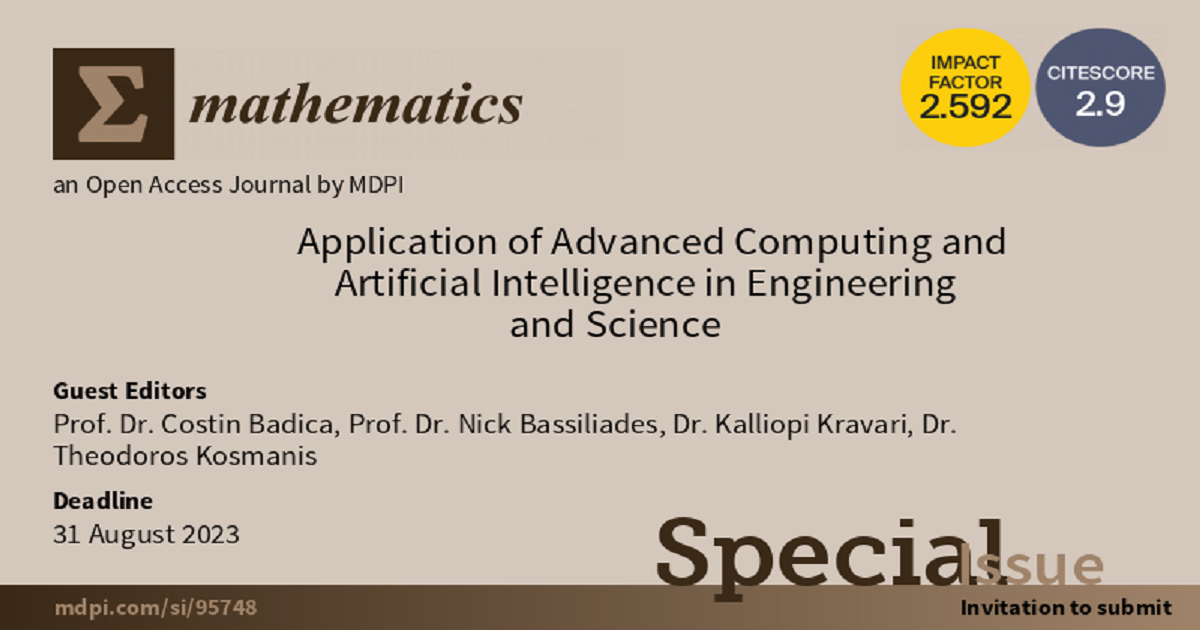Application of Advanced Computing and Artificial Intelligence in Engineering and Science
A special issue of Mathematics (ISSN 2227-7390). This special issue belongs to the section "E1: Mathematics and Computer Science".
Deadline for manuscript submissions: closed (31 August 2023) | Viewed by 31274

Special Issue Editors
Interests: artificial intelligence; multi-agent systems; software engineering; distributed systems; formal methods
Special Issues, Collections and Topics in MDPI journals
Interests: smart grids; electric vehicles; multi-agent systems; information integration
Special Issues, Collections and Topics in MDPI journals
Interests: semantic web and intelligent agents; intelligent multi-agent systems issues; trust management; knowledge representation and reasoning; logi
Special Issues, Collections and Topics in MDPI journals
Interests: vehicle electrification; automotive electrics/electronics; computational electromagne
Special Issues, Collections and Topics in MDPI journals
Special Issue Information
Dear Colleagues,
During the last decade, artificial intelligence reached a high level of maturity from scientific experimentation in labs to powerful applications in business and industry. AI comprises a rather wide range of methods and techniques spanning various approaches in symbolic and sub-symbolic information processing that evolved and matured during a short history of more than 50 years. They can be succinctly grouped into three intertwined classes of approaches comprising representation, reasoning and learning methods.
Modern AI techniques work hand-in-hand with advanced computing technologies based on computer networks and emerging computing architectures. Modern trends in advanced computing architectures include high-performance, cloud, edge, and fog computing, as well as IoT, distributed ledgers and blockchains.
Currently, AI technologies have penetrated virtually all areas of life and society. The recent technical performance of AI methods and technologies, as well as their impact in business and economy, present new and amazing achievements while also raising new scientific and practical challenges that require a careful investigation by the research community. In particular, the synergy between new AI technologies and applications with advanced computing architectures is seen to be of major importance. A notable example is the intertwining of decentralized computing and machine learning, which led to federated learning.
The topics of interest for this Special Issue address the application of advanced computing and artificial intelligence methods including, but not limited to:
- Machine learning (including classification and clustering, neural networks, deep and reinforcement learning, federated learning);
- Knowledge representation and ontologies;
- Reasoning (rule-based systems, logic programming, constraint satisfaction, theorem proving);
- Imprecise and uncertain reasoning (including Bayesian and fuzzy approaches);
- Combinatorial optimization and heuristic search;
- Bio- and nature-inspired computing;
- Natural language and speech processing;
- Computer vision;
- Distributed multi-agent systems;
- Agent-based modeling and simulation;
- High-performance, edge, fog, cloud computing, IoT
- Distributed ledgers and blockchains
to various fields of science and engineering including, but not limiting to:
- Autonomous driving;
- Electric vehicles;
- Smart Homes, smart cities and smart future;
- Hazard modeling and mitigation;
- Manufacturing and Industry 4.0;
- Remote sensing and operation;
- Robotics, automation and intelligent control;
- Energy management;
- Mobility, transportation and logistics;
- Agriculture 5.0 and Smart Farming;
- Healthcare and drug discovery.
Prof. Dr. Costin Badica
Prof. Dr. Nick Bassiliades
Dr. Kalliopi Kravari
Dr. Theodoros Kosmanis
Guest Editors
Manuscript Submission Information
Manuscripts should be submitted online at www.mdpi.com by registering and logging in to this website. Once you are registered, click here to go to the submission form. Manuscripts can be submitted until the deadline. All submissions that pass pre-check are peer-reviewed. Accepted papers will be published continuously in the journal (as soon as accepted) and will be listed together on the special issue website. Research articles, review articles as well as short communications are invited. For planned papers, a title and short abstract (about 100 words) can be sent to the Editorial Office for announcement on this website.
Submitted manuscripts should not have been published previously, nor be under consideration for publication elsewhere (except conference proceedings papers). All manuscripts are thoroughly refereed through a single-blind peer-review process. A guide for authors and other relevant information for submission of manuscripts is available on the Instructions for Authors page. Mathematics is an international peer-reviewed open access semimonthly journal published by MDPI.
Please visit the Instructions for Authors page before submitting a manuscript. The Article Processing Charge (APC) for publication in this open access journal is 2600 CHF (Swiss Francs). Submitted papers should be well formatted and use good English. Authors may use MDPI's English editing service prior to publication or during author revisions.
Keywords
- machine learning
- reasoning and knowledge representation
- heuristic search
- natural language processing
- computer vision
- multi-agent systems
- high-performance, edge, fog and cloud computing
- bio- and nature-inspired computing
Benefits of Publishing in a Special Issue
- Ease of navigation: Grouping papers by topic helps scholars navigate broad scope journals more efficiently.
- Greater discoverability: Special Issues support the reach and impact of scientific research. Articles in Special Issues are more discoverable and cited more frequently.
- Expansion of research network: Special Issues facilitate connections among authors, fostering scientific collaborations.
- External promotion: Articles in Special Issues are often promoted through the journal's social media, increasing their visibility.
- e-Book format: Special Issues with more than 10 articles can be published as dedicated e-books, ensuring wide and rapid dissemination.
Further information on MDPI's Special Issue polices can be found here.








